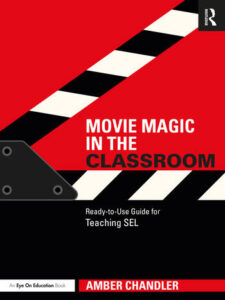Add Movie Magic to Boost SEL in Class
Movie Magic in the Classroom: Ready-to-Use Guide for Teaching SEL
By Amber Chandler
(Routledge/Eye On Education, 2023 – Learn more)
Reviewed by Sarah Cooper


Movie Magic makes good on all of these promises and more, offering easy and effective tools throughout. I especially appreciated the stop-and-chat guides, which provide topics, time stamps and chat questions.
For instance, for the book’s only docudrama, The Social Dilemma, Chandler lists this social-media related quotation at 36:59: “If it’s not that big a deal, then don’t use it for a week.” Chat questions that follow are “How would you fare? Could you go a week without any social media at all?” Teachers and students alike would be eager to answer these questions.
Similarly, each movie has a discussion guide with still more rich, approachable prompts, such as this one for Encanto: “This movie focuses a great deal on the expectations of ‘making your family proud.’ Is this a reasonable expectation or not? Explain your answer.” For Wreck-It Ralph, there’s a chart with nine quotes, including ones by Anne Lamott and Lei Wah and this wisdom from Oprah: “Real power comes by doing what you are meant to be doing, and doing it well.”
The appendices contain even more useful tools, such as a movie permission slip, alternate assignments for students not watching a particular movie, and an assessment choice board with activities organized under the headings Make, Organize, Verify, Integrate and Express.
The list of ten movies runs the gamut of themes and styles:
- Inside Out
- Encanto
- Soul
- The Mitchells vs. The Machines
- Wreck-It Ralph
- Lemonade Mouth
- Hidden Figures
- The Giver
- Dear Evan Hansen
- The Social Dilemma
Considering controversial content
Chandler is realistic about the controversial nature of some of these films, acknowledging that some parents may not be comfortable, for instance, with their children seeing The Mitchells vs. The Machines, “where the family happens to have an autistic son, an openly queer daughter, and they are tasked with saving the universe.” Some years Chandler will show certain movies, and other years she will opt to skip them.
With the right films, though, she has found that students can “have meaningful conversations that were developmentally appropriate, yet dealt with racism, sexism, bias, and the importance of a global worldview.” In a time when many students are still “experiencing the trauma of several years of uncertainty, disrupted schooling, isolation, and a looming enemy that keeps mutating,” such conversations are crucial.
Inventive and practical
Beyond simply talking about movies, Chandler’s inventive teaching shines, through both personal stories about her childhood as a movie watcher and constant small ideas that can perk up a classroom. As an example, “One of the ways I introduce a new novel or unit is to find quotes, print them out in different fonts, and tape them to my classroom door. I purposely give them no context, and I don’t mention it.” Then she might host a digital chat on the first day of the unit, with students agreeing or disagreeing with a quotation and explaining why.
Chandler is also refreshingly practical, explaining that in a recent year she ended up showing The Giver instead of reading it because of “state assessments, spring break, and final exams.”
Ultimately, Movie Magic will help you connect with students, encourage them to connect with each other, and lead them to understand themselves better in this time that calls out for emotional intelligence.
Sarah Cooper teaches eighth-grade U.S. history and is Associate Head of School at Flintridge Prep in La Canada, California, where she has also taught English Language Arts. Sarah is the author of Making History Mine (Stenhouse, 2009) and Creating Citizens: Teaching Civics and Current Events in the History Classroom (Routledge, 2017). She presents at conferences and writes for a variety of educational sites. You can find all of Sarah’s writing at sarahjcooper.com.


































